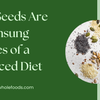Health Benefits of Different Rice Varieties
- by K V
Health Benefits of Different Rice Varieties
Rice is a kitchen staple in many homes, providing a versatile and affordable base for countless meals.
While there are numerous varieties available, three of the most common are brown rice, white rice, and basmati rice. Let's take a closer look at the unique nutritional advantages of each.
Top 4 Rice Varieties: Exploring Flavor, Texture, and Nutrition
- Brown Rice
Brown rice is a wholegrain that retains its nutrient-packed bran layer and germ during processing. This makes it a nutritional champion compared to refined white rice.
Nutritional Benefits:
- High in fibre (3.5g per cooked cup) to aid digestion and promote fullness
- Good sources of B vitamins like niacin and B6
- Contains useful minerals like magnesium, phosphorus, manganese, and selenium
- Low glycemic index to release energy gradually without spiking blood sugar
Unique Properties:
- Wholegrain with nutrient-packed bran layer and germ intact
- Chewy texture and nutty flavour
- It suits dishes like stir-fries, curries, pilafs, and rice bowls
- White Rice
By far the most popular variety in the UK, white rice is produced by removing the bran and germ from brown rice grains during processing. This makes it lower in fibre, vitamins, and minerals compared to its whole grain counterpart. However, white rice remains a valuable source of energy due to its high carbohydrate content.
Nutritional Benefits:
- Good source of energising carbohydrates
- Lower in fibre, vitamins, and minerals than brown rice
- Easier to digest for sensitive stomachs
Unique Properties:
- Bran and germ removed during processing
- Mild, plain flavour complement boldly seasoned dishes
- Inexpensive and shelf-stable
- Basmati Rice
Basmati is an aromatic long-grain rice traditionally grown in the foothills of the Himalayas. When cooked, its grains develop a fluffy, non-sticky texture with a distinctive nutty, almost floral aroma.
Nutritional Benefits:
- Supplies carbohydrates for energy
- Contains small amounts of B vitamins and minerals
- Low to medium glycemic index for controlled blood sugar impact
Unique Properties:
- Aromatic long-grain rice with fluffy, non-sticky cooked texture
- Distinct nutty, almost floral aroma
- Ideal for Indian and Middle Eastern cuisine
- Jasmine Rice
Jasmine rice, named for its delicate jasmine flower scent, is a long-grain variety prized in Thailand. Unlike basmati, jasmine rice has a subtler, sweeter aroma that complements the bold flavours of Southeast Asian cuisine.
Nutritional Benefits:
- Similar to basmati rice, it contains carbohydrates for energy, small amounts of B vitamins and minerals, and a low to medium glycemic index.
Unique Properties:
- Long-grain rice with a slightly sticky texture when cooked
- Subtly sweet, jasmine flower fragrance
- Ideal for Southeast Asian dishes like curries, pad thai, and mango sticky rice
All three of these rice varieties can be part of a balanced diet when sensible portion sizes are observed. The higher fibre content and lower GI value of brown rice and basmati give them an edge nutritionally versus plain white rice.
However, varying the types you eat allows you to enjoy different flavours, textures, and cultural cuisines while still benefiting from this affordable and versatile grain.
- Posted in:
- blog
- health benefits
- maven wholefoods
- natural foods
- Organic Farming
- organic foods
- organic rices
- rice
- Vegan
- Vegan food
- whole foods





